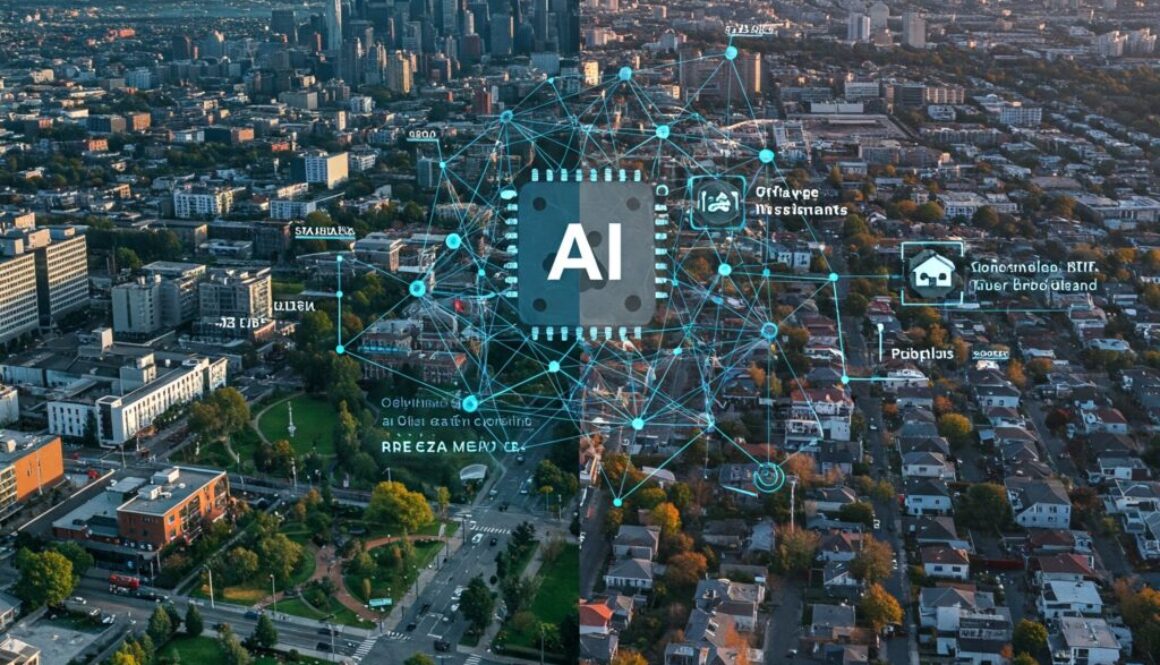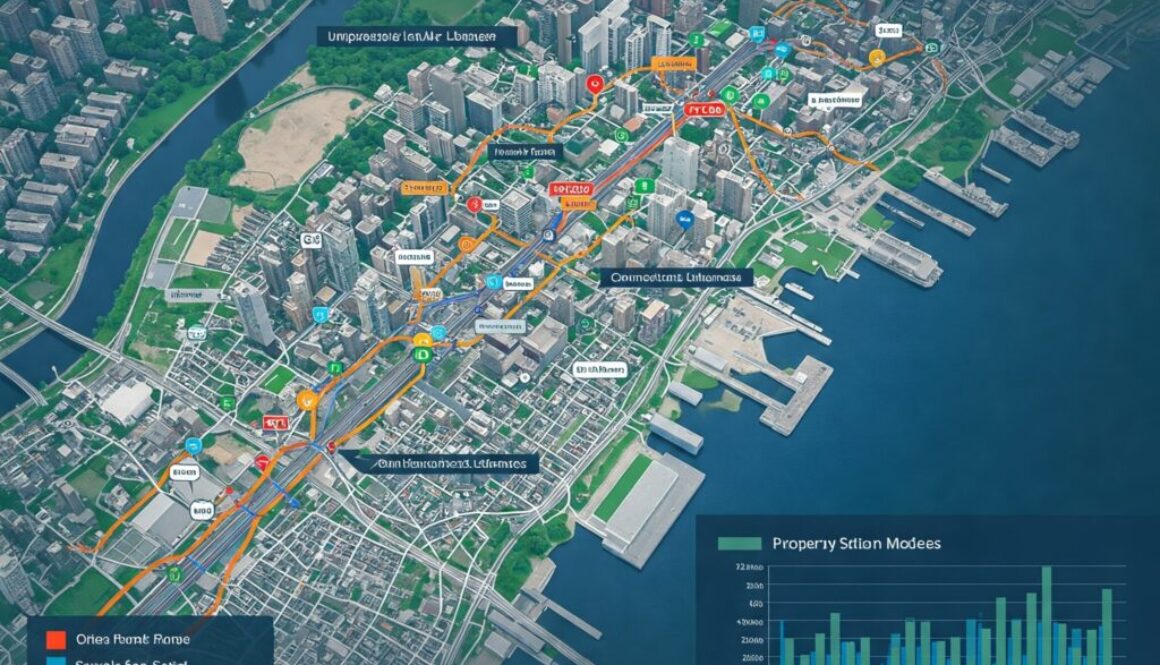Population Growth Trends: Using AI to Find Tomorrow’s Hot Markets
bai.innovation.research@gmail.com Uncategorized
Population growth has always been a fundamental driver of real estate demand and value appreciation. Areas experiencing significant population increases typically see corresponding growth in housing needs, retail spending, service requirements, and overall development activity—all factors that can positively impact real estate investments.
Traditional approaches to analyzing population growth typically rely on historical census data, recent growth rates, and broad demographic projections. While these methods provide some insight, they often lag behind emerging trends, miss nuanced growth patterns, and fail to identify early-stage growth catalysts before they become widely recognized.
In 2025, AI-powered geospatial intelligence platforms like Locas.dev are transforming population trend analysis, using sophisticated algorithms and diverse data streams to identify tomorrow’s growth markets before conventional indicators reveal them—providing investors with a critical time advantage in recognizing emerging opportunities.
The Evolution of Population Trend Analysis in Real Estate
Traditional Approach
Conventional population growth assessment typically involves:
- Reviewing census data and official population estimates
- Analyzing recent growth rates at city or county level
- Following general migration trends between regions
- Noting major employer expansions or relocations
- Observing residential construction activity as a growth indicator
This approach has significant limitations:
- Data lag issues with official population statistics
- Overgeneralized geographic focus missing neighborhood-level patterns
- Limited leading indicator incorporation beyond obvious signals
- Minimal pattern recognition across similar growth trajectories
- Poor prediction of growth acceleration or deceleration points
“Traditional population analysis tends to be retrospective, telling you where growth has already occurred rather than where it’s about to happen,” explains demographic economist Dr. Emma Rodriguez. “By the time conventional indicators clearly show population momentum, property prices have typically already adjusted to reflect this growth, significantly reducing investment advantage.”
How AI Transforms Population Growth Analysis
Modern geospatial intelligence platforms transform population trend analysis through:
1. Early-Stage Growth Signal Detection
Traditional Approach: Reliance on lagging indicators like official population estimates or completed housing units, which typically identify growth patterns only after they’re well established.
AI-Enhanced Approach: Sophisticated early-signal intelligence includes:
- Non-traditional data source integration revealing emerging patterns
- Subtle behavioral indicator analysis preceding physical moves
- Digital footprint pattern recognition showing relocation interest
- Pre-move activity identification across various services
- Growth catalyst detection before population response materializes
Real-World Impact: “The AI platform identified unusual patterns in internet search behavior, mail forwarding requests, and rental inquiries focused on a previously overlooked suburb,” notes Jennifer Wu of Horizon Investments. “These early signals preceded official population data by 14-18 months, allowing us to acquire properties at pre-growth prices in an area that subsequently experienced 16% population growth and 28% property appreciation over three years—an opportunity completely missed by investors relying on traditional demographic data.”
2. Micro-Geographic Growth Pattern Recognition
Traditional Approach: Analysis of population changes at broad jurisdictional levels (cities, counties), missing the neighborhood-specific patterns that create the most targeted investment opportunities.
AI-Enhanced Approach: Detailed micro-pattern intelligence includes:
- Block-level growth trend identification
- Neighborhood-specific migration pattern analysis
- Development spread trajectory mapping
- Growth boundary evolution tracking
- Pocket opportunity recognition within broader regions
Real-World Impact: A developer used micro-geographic analysis to identify specific neighborhood sections experiencing accelerated growth despite moderate city-level statistics. The AI platform detected precise boundaries of expansion radiating from a successful initial development, allowing them to acquire parcels directly in the path of this growth progression. These strategic acquisitions appreciated 34% faster than properties just a few blocks away but outside the specific growth vector—a pattern invisible in traditional jurisdiction-wide data.
3. Population Composition Prediction
Traditional Approach: Simple focus on overall population numbers without detailed analysis of how demographic composition might be evolving in specific locations.
AI-Enhanced Approach: Sophisticated composition intelligence includes:
- Age cohort migration pattern analysis
- Income profile evolution prediction
- Household structure forecasting for different areas
- Occupation and industry mix projection
- Lifestyle segment growth trajectory mapping
Real-World Impact: “Our AI analysis not only identified population growth in our target area but predicted a significant shift in demographic composition toward higher-income, technology-sector professionals,” explains Michael Chen of Summit Development. “This intelligence allowed us to design a residential project specifically tailored to this emerging population segment, achieving premium pricing and rapid absorption compared to more generically positioned competing developments.”
4. Growth Sustainability Assessment
Traditional Approach: Assumption that recent growth trends will continue, with limited ability to assess underlying sustainability factors or predict potential inflection points.
AI-Enhanced Approach: Comprehensive sustainability intelligence includes:
- Growth driver diversity evaluation
- Economic foundation stability assessment
- Infrastructure capacity analysis relative to growth patterns
- Affordability threshold modeling for continued expansion
- Competitive position monitoring against alternative locations
Real-World Impact: An investor compared two high-growth markets using sustainability assessment. While both showed similar recent population increases, the AI platform identified significantly different sustainability profiles. One area relied primarily on a single employment sector with concerning volatility indicators, while the other demonstrated diverse growth drivers and strong infrastructure capacity. By focusing investments in the more sustainable growth market, they avoided major valuation challenges when the single-driver market experienced a subsequent growth reversal.
5. Growth Catalyst Prediction
Traditional Approach: Reactive recognition of major growth catalysts like corporate relocations after they’re publicly announced, missing the opportunity to anticipate likely catalyst locations.
AI-Enhanced Approach: Forward-looking catalyst intelligence includes:
- Corporate expansion pattern analysis
- Infrastructure investment impact modeling
- Educational and institutional growth effect prediction
- Amenity development influence projection
- Policy and regulatory change opportunity identification
Real-World Impact: “The AI platform identified our region as matching the specific pattern of characteristics that had preceded major corporate relocations in similar areas,” notes Sarah Johnson of Meridian Investments. “Based on this intelligence, we acquired strategic properties 18 months before a major technology company announced their new campus location. This catalyst prediction created exceptional returns as property values surged following the official announcement—an advantage unavailable through conventional analysis.”
Case Study: The Crossroads Growth Portfolio
When Capital Partners was developing a multi-market investment strategy focused on population growth opportunities, they employed both traditional demographic assessment and AI-powered growth analysis:
Traditional Assessment:
- Review of census data and recent population estimates
- Analysis of published growth rates for target metros
- Examination of major employer announcements
- Observation of construction activity levels
- Consultation with local economic development offices
AI-Enhanced Intelligence:
- Early-signal detection identifying four markets with growth inflection points 12-18 months ahead
- Micro-geographic analysis pinpointing specific neighborhood sections with superior growth vectors
- Composition prediction showing valuable demographic shifts missed in overall population numbers
- Sustainability assessment identifying critical differences in growth foundation quality
- Catalyst prediction highlighting two markets with high probability of major growth announcements
Based on this comprehensive intelligence, Capital Partners:
- Prioritized markets showing early growth signals before official statistics reflected acceleration
- Targeted specific neighborhood sections with optimal growth trajectory patterns
- Adjusted property types and designs to match predicted demographic composition changes
- Avoided markets with unsustainable growth indicators despite strong recent performance
- Positioned strategic acquisitions in areas with high catalyst probability
The result was a portfolio that outperformed comparable growth-focused investments by 31% over a five-year period, with particularly strong results in markets where early growth detection created timing advantages and catalyst prediction provided strategic positioning opportunities.
Key Growth Trend Factors for Comprehensive Assessment
Modern geospatial intelligence platforms analyze several critical dimensions to identify emerging growth markets:
1. Early Behavioral Indicators
- Digital search pattern analysis showing location interest
- Rental inquiry trend monitoring across platforms
- Relocation service utilization data
- School enrollment inquiry patterns
- Remote work location flexibility utilization
2. Economic and Employment Drivers
- Job creation rate and quality assessment
- Industry growth pattern analysis
- Remote work enablement levels
- Wage growth trajectory comparison
- Business formation and expansion monitoring
3. Infrastructure and Development Factors
- Transportation improvement impacts
- Utility capacity expansion patterns
- Educational quality evolution trends
- Healthcare facility development effect
- Amenity expansion trajectory analysis
4. Housing Market Dynamics
- Supply-demand imbalance identification
- Affordability threshold assessment
- Housing inventory evolution tracking
- Rental market pressure indicators
- Development pipeline adequacy analysis
5. Policy and Governance Influence
- Zoning and regulatory evolution patterns
- Development incentive implementation effects
- Tax policy impact on migration decisions
- Public investment prioritization impact
- Regional cooperation effectiveness assessment
Implementing Growth Intelligence in Your Investment Strategy
To leverage these advanced capabilities in your real estate investment approach:
1. Focus on Leading Indicators Rather Than Lagging Statistics
Shift from retrospective to predictive growth analysis:
- Monitor early behavioral signals preceding physical moves
- Track subtle changes in interest patterns toward specific areas
- Identify catalyst development before population response
- Analyze pre-transaction activity indicating future moves
- Recognize growth inflection points before they appear in official data
2. Target Micro-Geographic Opportunities
Move beyond broad market analysis to hyper-specific targeting:
- Identify specific neighborhood sections with optimal growth vectors
- Recognize precise boundaries of expanding development patterns
- Focus on block-level growth trends rather than city-wide statistics
- Understand growth corridor evolution within broader regions
- Target properties directly in the path of observed expansion patterns
3. Match Investments to Emerging Population Composition
Align property strategy with projected demographic shifts:
- Identify specific population segments growing in target areas
- Design and position properties to match emerging demographic preferences
- Recognize changing household composition patterns early
- Adjust amenities and features to anticipated resident profiles
- Develop marketing approaches aligned with incoming population segments
4. Evaluate Growth Sustainability Fundamentals
Look beyond current growth rates to underlying sustainability:
- Assess diversity of economic drivers supporting population growth
- Evaluate infrastructure capacity relative to growth projections
- Analyze affordability dynamics affecting continued expansion
- Consider competitive position against alternative growth markets
- Monitor policy and regulatory environment affecting growth potential
5. Position Around Potential Growth Catalysts
Strategically anticipate major growth events:
- Identify areas with characteristics matching previous catalyst locations
- Position investments in catalyst impact zones before announcements
- Develop properties that complement potential catalyst effects
- Structure acquisition timing around projected catalyst emergence
- Create flexibility for accelerated development if catalysts materialize
The Future of Growth Trend Intelligence
As AI and geospatial intelligence continue to evolve, several emerging capabilities promise even more sophisticated growth market identification:
Real-Time Population Flow Monitoring
Future systems will track population movement patterns in near-real-time through anonymized mobile data, providing immediate insights into emerging relocation trends before they appear in any official statistics.
Personalized Growth Opportunity Matching
Advanced platforms will match specific growth markets to your investment strategy, property types, and operational capabilities, identifying the precise locations where emerging growth patterns align with your unique approach.
Dynamic Catalyst Probability Updating
AI will continuously recalculate catalyst probability as conditions evolve, providing constantly updated forecasts of major growth events based on the latest indicators and signals.
Multi-Scenario Growth Modeling
Future intelligence will model multiple potential growth trajectories based on different catalyst and condition combinations, helping investors develop optionality-based strategies for various growth scenarios.
Cross-Market Growth Pattern Learning
Platforms will increasingly recognize growth patterns as they emerge in one market and identify early-stage versions of the same pattern in other locations, providing cross-market prediction capabilities.
Conclusion: From Following Growth to Anticipating It
Population growth remains a fundamental driver of real estate opportunity, but the competitive advantage increasingly belongs to those who can identify tomorrow’s growth markets today. The evolution from lagging indicators to sophisticated AI-powered growth intelligence enables investors to:
- Recognize growth patterns 12-18 months before official statistics
- Target specific micro-locations with optimal growth trajectories
- Anticipate demographic composition shifts affecting property demand
- Assess growth sustainability beyond simple recent performance
- Position strategically around emerging growth catalysts
In a market where timing is everything, the ability to identify growth markets in their earliest stages represents one of the most powerful competitive advantages available to real estate investors.
Ready to discover tomorrow’s growth markets before everyone else? Try Locas.dev today and experience the power of AI-driven population trend intelligence for your real estate investments.
This article reflects the current state of AI technology in population trend analysis for real estate. For the latest updates and features, visit Locas.dev.
Keywords: population growth real estate, growth market identification, emerging property markets, demographic trend analysis, AI population prediction, real estate growth markets, future property growth areas









